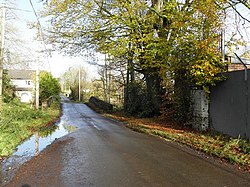Doagh
| Doagh Scots: Doach | |
| County Antrim | |
|---|---|
 Hollybank Road, Doagh | |
| Location | |
| Grid reference: | J261895 |
| Location: | 54°44’17"N, 6°2’31"W |
| Data | |
| Post town: | Ballyclare |
| Postcode: | BT39 |
| Local Government | |
| Council: | Antrim and Newtownabbey |
Doagh is a village (and a townland) in County Antrim, is in the valley of the Six Mile Water, about two miles south-west of Ballyclare. It had a population of 1,130 people at the 2001 census.
The name of the village is from the Irish Dumhach, meaning "Mound".[1] It is known as Doach in Ulster Scots.[2]
Traditional houses stand in the village centre but the village has gradually grown and new housing estates have been built on its outskirts.
History
There is evidence of settlement in the vicinity at least from the Iron Age, and possibly the Bronze Age, as represented by the Holestone and traces of numerous souterrains in the surrounding fields.
The substantial base of a Norman motte, overlooking the Six Mile Water, is clearly visible at Lindsay's corner on the outskirts of the village.
The first Sunday school in Ireland is said to have been founded by William Gault in Doagh, on the site where the Methodist Church now stands, although there is no firm evidence to support this claim. The Methodist church was established in 1844.
Gault was also associated with the Doagh Book Club and radical 18th century Protestantism. The book club was destroyed by a detachment of Dragoons in the early 19th century.
Places of interest
On a hilltop about a mile from Doagh is a Bronze Age whinstone megalith known as The Holestone. Couples used to promise marriage by clasping hands through the hole in the stone, a convention that can be traced back to about 1830.[3] W.G. Wood-Martin in 1902 asserted speculatively that it was anciently "connected with aphrodisiac customs." Even today, newlyweds, together with the wedding party, will visit the stone in observance of the ancient local custom.
There are a number of buildings of architectural interest either in or proximate to the village.[4] These include Fisherwick Lodge, a hunting lodge built for the Marquess of Donegall (1805), and Holestone House. Industrial architecture is well represented in some of the remaining mill buildings; the best being at nearby Cogry.[5]
The cemetery at Kilbride (a townland bearing the name of St Brigid) contains the 19th century Stephenson Mausoleum, built in the style of a mogul palace. It is today a listed building. It also contains numerous gravestones reflecting a history of emigration and war. In this cemetery is the headstone of William Gault, the founder of the Sunday school.
A memorial to John Rowan stands in the middle of the village. Rowan, a linen spinner who invented a steam driven vehicle later claimed to be the first motorcar, was born in Doagh in 1787 and died in Belfast in 1858.
Transport
Doagh was formerly the terminus of a branch line of the narrow gauge Ballymena and Larne Railway. The line was extended from Ballyclare to Doagh in 1884. Passenger services between Doagh and Ballyclare were withdrawn in 1930, and freight services in 1933.
Sport
- Football: F.C. Ballynure
- Hockey: Parkview Hockey Club is based in Doagh.
References
- ↑ Doagh - Placenames NI
- ↑ The Online Scots Dictionary
- ↑ Zucchelli, Christine: 'Stones of Adoration. Sacred stones and Mystic Megaliths of Ireland' (The Collins Press, 2007) page 126
- ↑ Brett, CEB, O'Connell, M. Buildings of County Antrim, Belfast. Ulster Architectural Heritage Society. 1996
- ↑ McCutcheon, W, A.: 'The Industrial Archaeology of Northern Ireland' (Department of the Environment for Northern Ireland, 1981)